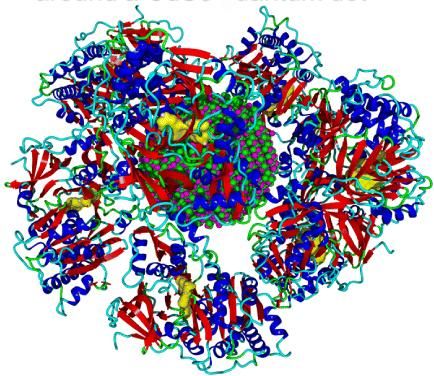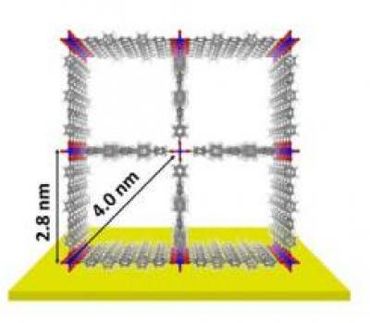Shining a light on quantum dots measurement
Due to their nanoscale dimensions and sensitivity to light, quantum dots are being used for a number of bioimaging applications including in vivo imaging of tumor cells, detection of biomolecules, and measurement of pH changes. When quantum dots are introduced in biological media, proteins surround the nanoparticles and form a corona. The formation of the protein corona changes the sensitivity of the quantum dots to light.

This is the protein corona of firefly luciferase around a CdSe quantum dot.
Shikha Nangia and Arindam Chakraborty
Using the cadmium selenide quantum dot, researchers at Syracuse University collaborated to understand how protein corona forms and what is different about the quantum dot before and after the formation of the corona.
Research performed by Professor Shikha Nangia, in the Department of Biomedical and Chemical Engineering, and Professor Ari Chakraborty, in the Department of Chemistry, resulted in the development of a novel multilevel computational approach. This method combines the strengths of quantum mechanics, molecular mechanics, classical molecular dynamics, and Monte Carlo techniques. Because of this work, it is now possible to perform computer simulation of protein-quantum dot complexes that were previously considered to be beyond the scope of computational investigations. Now that this methodology has been created, it can be applied to bigger and more complex quantum dot systems.
Original publication
"Optical Signature of Formation of Protein Corona in the Firefly Luciferase-CdSe Quantum Dot Complex."; Journal of Chemical Theory and Computation.
Original publication
"Optical Signature of Formation of Protein Corona in the Firefly Luciferase-CdSe Quantum Dot Complex."; Journal of Chemical Theory and Computation.
Organizations
Other news from the department science

Get the chemical industry in your inbox
By submitting this form you agree that LUMITOS AG will send you the newsletter(s) selected above by email. Your data will not be passed on to third parties. Your data will be stored and processed in accordance with our data protection regulations. LUMITOS may contact you by email for the purpose of advertising or market and opinion surveys. You can revoke your consent at any time without giving reasons to LUMITOS AG, Ernst-Augustin-Str. 2, 12489 Berlin, Germany or by e-mail at revoke@lumitos.com with effect for the future. In addition, each email contains a link to unsubscribe from the corresponding newsletter.



















































